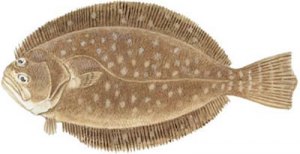The Light and Dark Side of Flounder Conservation

Much has been written about flounder conservation lately. People claim that stocks are collapsing and the fishery is in crisis. What is going on with southern flounder? Let’s shed some light on the dark side of flounder conservation.
All of us served on the NC Marine Fisheries Commission (MFC), which is empowered by the General Assembly to conserve our state’s fishery resources and to provide fair regulation of commercial and recreational fishing groups. We have had to make hard decisions serving in slots dedicated to scientists (two of us are marine fishery biologists), recreational fishermen and at-large positions. During our tenures we believed then, as we do now, that our leaders should use scientific facts and economic/social data to determine appropriate action in difficult conservation decisions.
The status of the southern flounder population is unknown. The latest population assessment (the main tool used to determine population health) was rejected by reviewers and the state’s fishery experts.
We do know a lot though, because the state has collected extensive data on flounder for over 35 years. The rate fishermen are removing flounder from the population (fishing mortality) has decreased or leveled off since 2007 (however, flounder was overfished then). Sizes of flounder in commercial catches have remained unchanged for over 20 years (they live only up to 8yrs), indicating that the population is replenishing itself. There have been high proportions of immature fish in catches since 1991, but there has been little change in those percentages, indicating the population is sustaining itself.
Surveys tracking the abundance of young flounder in North Carolina show no declining trends for over 25 years; in fact, some exhibit upward trends in numbers. Surveys in South Carolina and Georgia show declines, but their surveys are not nearly the magnitude of North Carolina’s. We have known for over 20 years that some (maybe many) of our flounder migrate to the ocean to spawn, where they escape intense fishing pressure.
Commercial fishing effort for gill nets and pound nets (greatest harvesters of flounder) has been substantially reduced. The state issued almost one thousand pound nets permits in 1994; today, only 280 permits exist. Since 2010, lengths of gill nets used to catch flounder have been reduced by 33% and fishing times have been reduced 50%. Extensive flounder gill net fishing areas have been closed due to interactions with protected sea turtles. Southern flounder harvest has been reduced by 39% from 2011 to 2014.
The General Assembly, with the Fishery Reform Act of 1997, revamped fisheries governance, creating a fishery management plan (FMP) and amendment process to bring science and other facts forward and have discussion with advisory committees in open meetings. In 2010 the General Assembly added another FMP process called a “supplement” that was supposed to deal with one management issue, not involve advisors and be used only if the long term viability of the fishery was at risk. The MFC recently chose to pursue this “supplement” process instead of a FMP amendment for southern flounder. Without any science to guide what options could sustain the fishery, the MFC arbitrarily picked measures they felt targeted 25-65% reductions in catch for the “supplement.”
Some claim that a 40% harvest reduction is needed to avoid a collapse of the stock, but there is no science to support that such measures are necessary. Some of the “supplement” options include banning flounder gill nets, lengthening the current closed season and other measures that will have harsh economic impacts. Perhaps most disturbing is that the MFC has yet to receive any recommendations on the options from the Division of Marine Fisheries, professional experts who are supposed to guide the MFC on scientific and economic/social facts.
In today’s world, if one repeats things often enough people often believe it true and the court of public opinion swayed. We hope these facts shed some light on the very important issue of flounder conservation. We urge our state’s decision-makers to use the truth and not rhetoric to determine what is the right thing to do with regards to flounder stewardship. North Carolina and our wonderful resources deserve no less.
Former North Carolina Marine Fisheries Commissioners
Jess H. Hawkins lll at-large appointment
Edward L. Mann Sr - recreational fisherman appointment
Dr. Allyn Powell - scientist appointment
William T. (Rusty) Russ - recreational fisherman appointment
Dr. Barbara Garrity-Blake – at-large appointment



